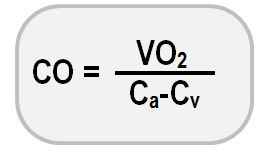Fellow Chalk Talk: Cardiogenic Shock w/ Dr. Mahida
/Objectives:
Compare the physiology of cardiogenic vs distributive vs hypovolemic shocks
Define and use the equations for Cardiac output (CO), Cardiac Index (CI), and Systemic Vascular Resistance (SVR)
Develop a framework for the initial approach to treatment of cardiogenic shock
Review your cardiogenic shock terminology before the video:
+ Mean Arterial Pressure
- MAP = 1/3 Systolic Pressure + 2/3 Diastolic Pressure
+ Cardiac Output
- CO = Heart Rate * Stroke Volume
- Fick's Method of measurement:
- This is based on the idea that the same amount of blood that leaves the heart will return to the heart, driven by the cardiac output. In the equation below, VO2 is how much oxygen the body uses, which is the difference between Arterial (Ca) and Venous (Cv) oxygen concentrations.
- Rearranging that equation for CO, we get the following:
- When we are calcuating cardiac output at bedside with a Swan Ganz, we can use a predict VO2 and can measure the oxygen content leaving the heart (PaO2) and returning to the heart (CvO2).
- This is based on the idea that the same amount of blood that leaves the heart will return to the heart, driven by the cardiac output. In the equation below, VO2 is how much oxygen the body uses, which is the difference between Arterial (Ca) and Venous (Cv) oxygen concentrations.
+ Systemic Vascular Resistance
- SVR = 80 * (MAP - CVP) / CO
- Note that SVR is calculated from CO and MAP. To get to a target SVR in a cardiogenic shock patient, you can either decrease the MAP or increase the CO to achieve that goal, depending on the clinical situation.
+ Cardiac Index
- CI = CO / BSA
+ Cardiogenic Shock
- CI < 2.2
Video:
Questions from Talk:
+ Who gets a CardioMEMs device?
- This does not depend on EF, but is more clinically determined. Patients with recurrent admissions, need for recurrent RHC could benefit from a CardioMems device.
CardioMems is a implanted device in the PA which transmits PA pressures and allows you to have a better idea of volume status before it becomes apparent on clinical exam, allowing for earlier and more efficient diuresis.

+ Should we use Cardiac Output or Cardiac Index?
- Cardiac index is the better number to follow as it is relative to the size of the patient. Review the equations above.
+ Does treating cardiogenic shock from a valvular issue change management in terms of what ionotrope we use?
- Short answer - no. Ionotrope use will not change based on valvular pathology.
- From SHOCK Registry: "LV failure was responsible in 79 percent, severe mitral regurgitation in 7 percent, ventricular septal rupture in 4 percent, isolated RV shock in 2 percent, tamponade (including subacute LV free wall rupture) in 1.4 percent, and other causes in 7 percent (eg, prior severe valvular disease, excess beta blocker or calcium channel blocker therapy, and shock resulting from a complication of cardiac catheterization)."
+ How do Swan Ganz numbers affect management of cardiogenic shock with reference to ionotropes?
This is a big topic. Read up on pulm cath literature here, and how to interpret the wave forms and numbers
+ When do you consider a patient for advanced therapies (LVAD vs Heart Transplant)?
There are a number of indications for evaluating a patient for a heart transplant or advnaced support therapy, however what we discussed today during the talk was when to refer your heart failure patients to an advanced heart failure specialist - when they are showing evidence of end-organ-damage or if they are unable to tolerate goal-directed-medical-therapy due to being so hypotensive.
Submit additional questions and we will have our expert answer them
MKSAP 18 Questions:
Cards 56
Cards 11
Pulm 101
Pulm 65
Request a Fellow or Faculty for the next Chalk Talk
**As always, contact Gene (novikoyy@ucmail.uc.edu) if you’re interested in helping with out distanced learning.




